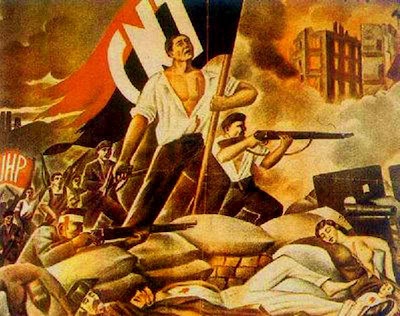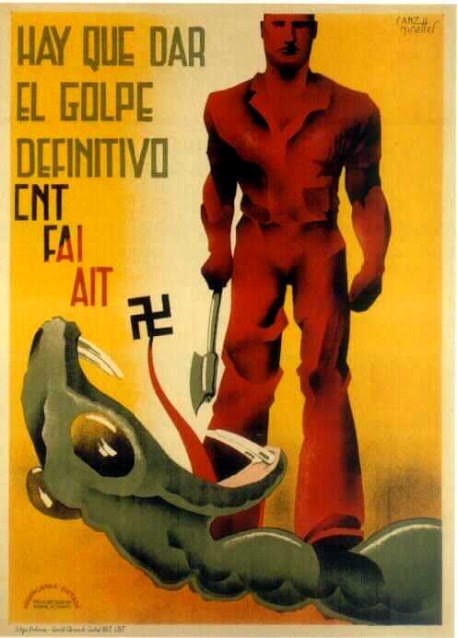Continuing with my installments from the “Anarchist Current,” the Afterword to Volume Three of Anarchism: A Documentary History of Libertarian Ideas, here I present my concluding remarks on the anarchists in the Spanish Revolution and Civil War. In Volume One of the Anarchism anthology, I included a chapter on the Spanish Revolution. I have also created a page on this blog on the anarchists in the Spanish Revolution which includes additional material that I was unable to fit into Volume One.
The CNT in the Spanish Civil War
The greatest controversy in which Abad de Santillán was involved arose from the decisions by the CNT during the Spanish Civil War to accept posts in the Catalonian governing council in September 1936 and, in November 1936, the central government in Madrid. In December 1936, Abad de Santillán became the Councillor of Economy in the regional government in Catalonia (the Generalitat). Not only did the “militants” of the FAI fail to prevent this fatal compromise of anarchist principles, some of the CNT ministers were themselves members of the FAI (such as Juan García Oliver, who became the Minister of Justice in the Madrid government, and Abad de Santillán himself). The decision to join the government was engineered by the National Committee of the CNT (which became the de facto ruling council of the CNT during the course of the Civil War) in order to obtain arms and financing, neither of which were forthcoming.
The decision of the CNT leadership to join the Spanish government was sharply criticized by many well known anarchists, including Camillo Berneri, Sébastien Faure, and Alexander Schapiro. Writing for the IWA publication, The International, the Swedish anarcho-syndicalist Albert Jensen (1879-1957) pointed out that it was by way of revolution that the workers in Catalonia had prevented General Franco from seizing power when he began the military revolt against the republican government in July 1936. Anarchists and syndicalists stormed military barracks, seized weapons and began collectivizing industry, while the republican government was in a state of virtual collapse. However, in order to maintain a “united front” against fascism, and to avoid imposing their own de facto dictatorship, the CNT-FAI decided it was better to work within the republican government rather than against it.
The problem was that, as Jensen pointed out, during a civil war the government “must have recourse always to dictatorship,” governing by decree and imposing military discipline, so instead of imposing an “anarchist” dictatorship the CNT-FAI was propping up a “counter-revolutionary” dictatorship, which hardly constituted “loyalty to [anarchist] ideas” and principles. “Wounded unto death, the State received new life thanks to the governmental participation of the CNT-FAI.” If the CNT-FAI had to work with other anti-fascists, whether capitalists or the authoritarian Communists loyal to Moscow, it would have been better for the CNT-FAI to remain outside the government, taking the position that “under no pretext, would they tolerate any attack on the revolutionary accomplishments and that they would defend these with all the necessary means” (Volume One, Selection 127).
The Spanish Revolution
In the factories and in the countryside, in areas that did not immediately fall under fascist control, there was a far-reaching social revolution. Spanish peasants collectivized the land and workers took over their factories. In the factories, the workers in assembly would make policy decisions and elect delegates to coordinate production and distribution. In the countryside, village and town assemblies were held in which all members of the community were able to participate.
In “the agrarian regions and especially in Aragon,” observed Gaston Leval (1895-1978), “a new organism appeared: the Collective.” The collective was not a trade union or syndical organization, “for it encompasses all those who wish to join it whether they are producers in the classic economic sense or not.” Neither was it a commune or municipal council, as it “encompasses at the same time the Syndicate and municipal functions.” The “whole population,” not merely the producers, “takes part in [the] management” of the collective, dealing with all sorts of issues, “whether it is a question of policy for agriculture, for the creation of new industries, for social solidarity, medical service or public education” (Volume One, Selection 126).
Although the anarchist collectives were ultimately destroyed, first by the Stalinist Communists in republican areas, and then by the fascists as they subjugated all of Spain, they constitute the greatest achievement of the Spanish anarchist movement. Through the crucible of the social revolution itself, the Spanish people developed this new, more inclusive form of libertarian organization which transcended the limits of anarcho-syndicalist trade union and factory committee forms of organization, inspiring generations to come.
Counter-Revolution in Spain
Those anarchists who attempted to work within the republican government were consistently outmaneuvered by the Republicans, Socialists and Communists. The areas in which anarchists were free to implement their ideas continued to shrink, but it was the May Days in Barcelona in 1937 that effectively marked the end of the anarchist social revolution in Spain. Factories and services under anarchist inspired workers’ self-management were attacked by Republican and Communist forces while they did battle with the anarchist militias, and several prominent anarchists were murdered, including Camillo Berneri and the Libertarian Youth leader, Alfredo Martinez. The CNT leadership negotiated a truce with the Republican government rather than engage in a “civil war” within the civil war. Hundreds of anarchists were killed in the fighting, and many more were imprisoned. The Socialists and Communists, unsuccessful in having the CNT declared illegal, forced them out of the government and continued their campaign of “decollectivization” and disarmament of the anarchist groups.
Given this disastrous turn of events, Abad de Santillán had second thoughts about the CNT’s policy of collaboration. By April 1937, he had already ceased being a member of the Catalonian cabinet. The following year he denounced those “anarchists” who had used their positions within the movement “as a springboard to defect to the other side where the pickings are easier and the thorns less sharp,” obtaining “high positions of political and economic privilege.” The CNT-FAI’s participation “in political power,” which he had also once “thought advisable due to circumstances, in light of the war,” had demonstrated “yet again what Kropotkin once said of the parliamentary socialists: ‘You mean to conquer the State, but the State will end up conquering you’” (Volume One, Selection 128).
Abad de Santillán noted that the self-styled anarchist “avant-garde,” who fancied themselves the “best trained, most prestigious, sharpest witted,” himself included, were not “in the vanguard of economic and social change” but instead “proved a hindrance, a brake, a hurdle to that change.” He had to admit that the “broad masses” of the Spanish people “were better prepared than their supposed mentors and guides when it came to revolutionary reconstruction.” For Abad de Santillán, by “standing with the State and thus against the people,” anarchists who were working within the Republican government were “not only committing an irreparable act of betrayal of the revolution,” they were “also betraying the war effort, because we are denying it the active support of the people,” who were becoming increasingly alienated from the Republican government as it sought to dismantle the anarchist collectives and other organs of self-management that had been created by the people themselves (Volume One, Selection 128).
Under the pressure of civil war, the CNT-FAI came more and more to resemble a conventional political party. The CNT’s National Committee would negotiate with the Republican government, and then present whatever deals they could get to the membership as a fait accompli. In effect, the “inverse” pyramidal federalist structure of the CNT was turned upside down, as the CNT began to function as a top-down political organization. The anarchist militias were dissolved, broken up or absorbed into the Communist dominated Republican army and subjected to strict military discipline (Richards, 1972).
Looking back on the Revolution and Civil War, José Peirats (1908-1989), active in the CNT and later its historian, believed that “those of us who consistently opposed collaboration with the government had as our only alternative a principled, heroic defeat.” Nevertheless, he was sympathetic to those principled anarchists for whom “the only solution was to leave an indelible mark on the present without compromising the future,” through their “constructive revolutionary experiments like the collectives, artistic and cultural achievements, new models of free, communal living.” This entailed “staying out of intrigues, avoiding complicity with the counterrevolution within the government, protecting the organization and its militants from the vainglory of rulers or the pride of the newly rich.” The seemingly insurmountable difficulties in maintaining these revolutionary achievements in the midst of civil war caused Peirats to question not these achievements, but “the idea of revolution” itself, conceived as a mass armed uprising seeking to overthrow the existing regime which inevitably degenerates into civil war (Peirats: 188-189), a critique further developed by Luc Bonet (Volume Three, Selection 12). This process of rethinking revolution was to be continued by many anarchists after the Spanish Revolution and the Second World War.
Robert Graham





Reblogged this on sergiofalcone.
[…] Image by robertgraham.wordpress.com […]